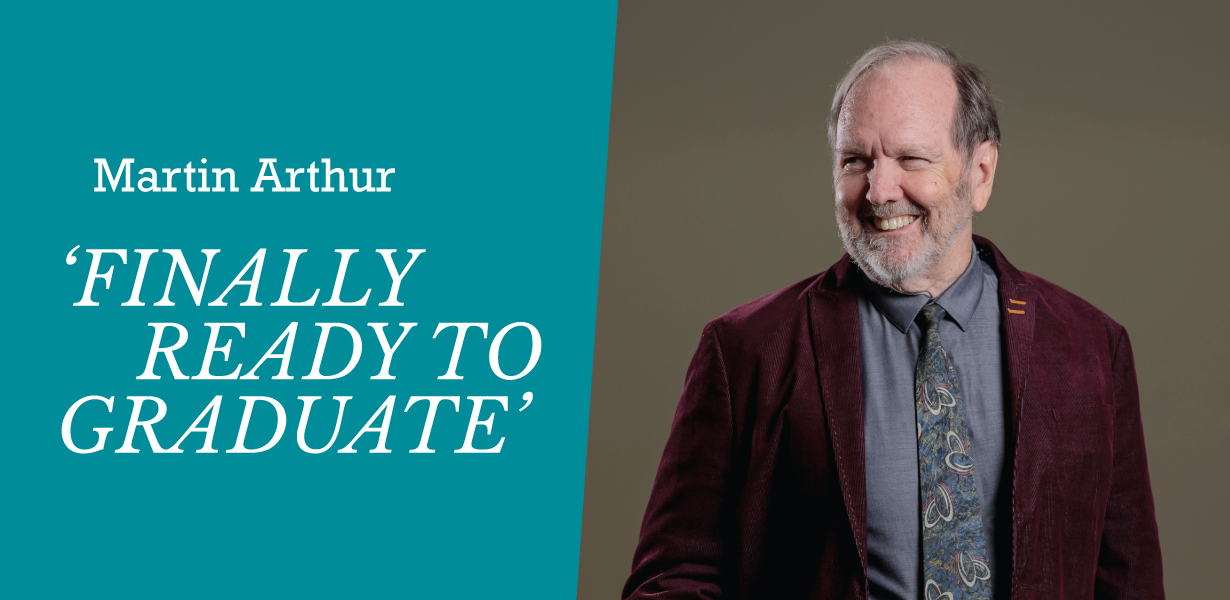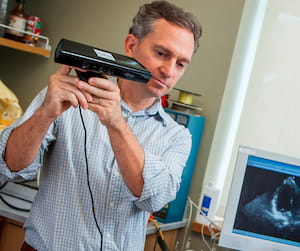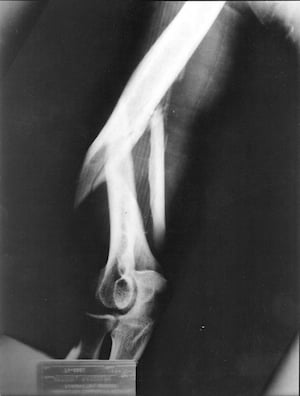Martin Arthur ‘Finally Ready to Graduate’

When R. Martin Arthur arrived at Washington University in St. Louis in 1969, "Get Back" by The Beatles was among the top hits and Neil Armstrong became the first person to walk on the moon. Over the course of his unprecedented 50-year career in the School of Engineering & Applied Science, he has made a difference in the education, careers and lives of thousands of Engineering students, all while carrying out his research in health care diagnostics, starting several companies and serving as department chair three times.

Arthur's long-standing place in the Department of Electrical & Systems Engineering will come to an end later this year when he leaves the university to continue working on his health care startup, ATM Cardiac Diagnostics LLC, which he formed with Jason Trobaugh, professor of the practice in electrical & systems engineering, and Scott Marrus, MD, a Washington University cardiologist at Barnes-Jewish Hospital.
"After 50 years, I'm finally ready to graduate and get a job," he says, with his characteristic dry humor.
WashU was a different place when Arthur arrived as a postdoctoral researcher to work with professors Russell R. Pfeiffer and Charles Molnar on peripheral auditory mechanisms: James M. McKelvey Sr. was dean; Urbauer and Bryan halls were new (Lopata and Jolley halls were yet to be built); and Jerome R. Cox Jr. and his team had brought the room-sized, then-revolutionary Laboratory Instrument Computer (LINC) — often considered the first personal computer — from Massachusetts Institute of Technology only five years prior.


1960s
PhD, University of Pennsylvania, 1968
MS, Rice University, 1964
BS, Rice University, 1963
BA, Rice University 1962

73 refereed journals
6 book chapters
49 refereed conference presentations
2015: Arthur co-founds a company with Jason Trobaugh (below) and Scott Marrus, MD
Arthur receives Faculty Award for Extraordinary Service from Engineering
"To me, that was the start of the university becoming world-class and put the medical school on the map," Arthur says. "Having the ability to have that personal computer made all the difference — it gave many here the ability to do things that weren't possible before that technology existed. Since then, the university has built on that initiative."
Arthur began teaching courses to first-year students almost immediately. As he moved through the ranks up to full professor, and eventually became the Newton R. and Sarah Louisa Glasgow Wilson Professor of Engineering in 2004, he has taught more than 150 courses, touching the lives of two generations of Engineering students.
Arthur has taught more than 150 courses, touching the lives of two generations of Engineering students.
"It's a huge responsibility," he says. "You're making judgments that effect students' careers because you're evaluating their work. It's a huge responsibility evaluating the performance of faculty for promotion and tenure, as well. I take it very seriously."
During his three stints as department chair, providing a high-quality and balanced curriculum to the department's undergraduate and graduate students is something else Arthur, who was named the 2018 Outstanding Professional Engineer in Education by the Missouri Society of Professional Engineers – St. Louis Chapter, has taken seriously.
"In my class, we were talking about communication theory, and I said they could get the basic information online, but you don't have a group to help you assimilate that information, understand what it means, and be able to create new intellectual property based on that experience," he says. "That's what keeps the brick-and-mortar universities going, because people like to work together, and it's the way people are most productive."
Not only has Arthur had a tremendous impact on the many students he has mentored in his lab, but with colleagues as well, including Michael E. Cain, MD, vice president for health sciences and dean of the Jacobs School of Medicine and Biomedical Sciences at the University of Buffalo.
"Martin was instrumental in opening my eyes in the 1980s to the value as an individual investigator, as well as to cardiology broadly, of collaborations between physician-scientists and engineers," Cain said. "Martin made it easy because the added and needed value he brought to our research program was obvious and because he was such a welcoming champion of collaboration. His direct impact on my work made me an advocate for further medicine/engineering partnerships at Washington University and now at the University at Buffalo."
“Highly intelligent people often have their quirks. One memory of Dr. Arthur that regularly comes to mind is the whiteboard in his laboratory. This whiteboard contained at least 20 years’ worth of the very most important information from his and his students’ work. Every square inch of the board was covered with markers of different colors, some items written with text as small as physically possible. When I last visited WashU a few years ago, there were still a few important facts from my days as a PhD nearly 20 years ago still on the board.”
— Daryl Beetner, professor and chair of the Electrical and Computer Engineering Department at Missouri University of Science and Technology.
In 1970, Arthur co-founded Aspen Signal with his mentors, Pfeiffer, who was chair of the Department of Electrical Engineering from 1971-75, and Don Snyder, department chair from 1976-86. Pfeiffer died unexpectedly, and the team closed Aspen in 1980. In 1984, he co-founded a company with William (Dave) Richard, professor of computer science & engineering, called Ultrasonics in Health Care, which develops computer architectures to support real-time ellipsoidal backprojection imaging.
His other research was aimed at identifying adults who have had a heart attack and are at increased risk of having another. Arthur and his colleagues identified small changes in different characteristics of electrocardiograms from at-risk patients. In addition, he devised algorithms for medical ultrasonic imaging for cancer using ultrasound to monitor temperature during heating and ablation therapy. He has been named a fellow of the American Institute for Medical and Biological Engineering for these activities.

After he leaves WashU, he will focus on the company he co-founded with Trobaugh and Marrus to get its two products from the lab into the market and the clinic. The company makes MiDetect, a device designed to detect ischemia, a shortage of oxygen, in patients who come to the emergency department with chest pain more quickly than can be done with current bioassays, then help to determine if the patient needs cardiac catheterization; and NICE, a full-body surface map for noninvasive cardiac evaluation. The team has a license from the university's Office of Technology Management and is working on a provisional patent.
While 50 years with one employer is nearly unheard of today, Arthur says the time has gone by quickly, attributing that to his focus on three things: competence, character and fun.
"If I'm not having fun, forget it," says Arthur, who lifts weights almost daily and has a penchant for symphonic metal music.
While Arthur does have fun with his students and colleagues, his competent and caring character shines through. He recalls a student who had some personal problems that were negatively affecting his academic performance. Arthur and a few colleagues gently encouraged the student to withdraw and return later to finish the degree.
"He appeared at my office door a few years later," Arthur says softly. "He was carrying a picture that his mother had made to thank me, and it's now over my mantle at home. He understood that we were all trying to help him. That's the good stuff. That's what it's about."
Back to Engineering Momentum